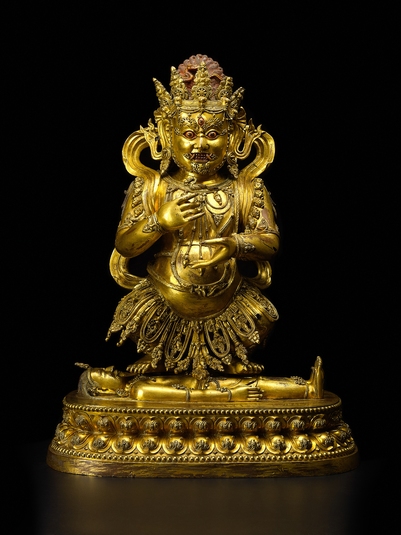
Item: Mahakala (Buddhist Protector) - Panjarnata (Lord of the Pavilion)
| Origin Location | China |
|---|---|
| Date Range | 1400 - 1499 |
| Lineages | Buddhist |
| Size | 74cm (29.13in) high |
| Material | Metal, Mercuric Gild |
| Collection | Private |
Panjarnata Mahakala (Tib. Gur-gyi Gonpo) is a popular figure in both painting and sculpture. He has been well represented in art over the past millennium with hundreds of excellent examples in a variety of styles originating from Pala-period India, spreading throughout the Himalayan regions, Northern China and beyond. From the Yuan dynasty (1279–1368), and Ming dynasty (1368–1644), Yongle (r.1403–1424) and Xuande periods (r.1425–1435), there are more than a dozen extant examples with a number of them being masterworks by any standard applied. The sculpture represented here is one of the very best examples of Chinese artistry and craftsmanship of the time. Two characteristics stand out above others as being truly impressive. First, the size of the piece (29 1/8 in., 74 cm. in height) is outstanding and the quality of the details fully in the round is the second.
Panjarnata is particularly important to and promoted by the Sakya tradition of Tibetan Buddhism, which has five main lineages of teachings associated with this form. As such, not all originated by adapting the Vajra Panjara Tantra. Since the present form of the deity is in sculptural form, the additional pieces of iconography including the deity’s retinue are absent and, thus, preclude us from further specifying the form of the deity we see here. Nevertheless, we know his primary role. The Sakya teachers were also dominant in the Mongol court during the Yuan dynasty.
The iconography of Panjarnata can vary somewhat, but differences are generally minor in appearance such as having either a squatting posture or carrying a 'ghandi' staff (Tib. ber-ka) across the forearms. Many of the sculptural examples that do not have a 'ghandi' might be missing the staff due to loss over time. His general appearance is that of a wrathful deity (Tib. dro lha) modeled from the descriptions of 'raksha' demons (Tib. sin-po) of Indian classical literature. Although generally known as a protector deity, Mahakala can also function as a meditational deity with many commentarial texts which remain closely guarded and relatively secret even into modern times.
Other common elements which can be seen here include a ferocious countenance with three bulging eyes, bared fangs, a crown of five human skulls along with a corpse underfoot, symbolizing the triumph over ego. Panjaranata has several early textual sources with the most commonly cited being the Hevajra Tantra. He can also be found in the specific Tantras popularly known as the Twenty-five Chapter and the Fifty Chapter Mahakala Tantras. The Panjarnata form was also adopted and incorporated into many Nyingma 'Revealed Treasure' (Tib. terma) teachings. Among the various traditions of Panjarnata he can be described as either solitary or having a number of named principal attendant figures numbering more than a dozen. As a protector in the political realm, Panjarnata played a significant role in Tibetan history and governance. In Tibet, Buddhism was closely intertwined with political power, and the protector deities, like Panjarnata, were believed to safeguard the state and its rulers. His image was often placed in monastic and administrative buildings to ensure the protection and well-being of the state. This was particularly common in China at various times beginning with Kublai Khan and the Yuan dynasty. The sculpture is dated according to the beautifully inscribed Imperial Xuande mark in calligraphic script.
Jeff Watt, 1-2024
Sculpture: Yongle Style, Xuande & Zhengtong Period
Sculpture: Yongle & Xuande Style (Masterworks)
Mahakala: Panjarnata, Lord of the Pavilion (Main Page)
Mahakala: Panjarnata Masterworks (Sculpture)
Mahakala: Panjarnata (Chinese Sculpture)
Subject: Video - Three Treasures at Sotheby's, New York (March, 2024)
Collection: Sotheby's New York (Sculpture, March, 2024)




